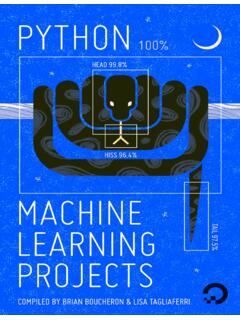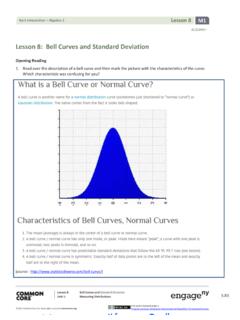Transcription of International License. This work is licensed under a ...
1 This work is licensed under a creative Commons attribution - noncommercial - sharealike 978-0-9997730-3-1 kubernetes for Full-Stack DevelopersCompiled by Jamon Camisso, Hanif Jetha, Katherine JuellDigitalOcean, New York City, New York, USA2020-01 kubernetes for Full-Stack Developers1. About DigitalOcean2. Preface - Getting Started with this Book3. Introduction4. An Introduction to Kubernetes5. How To Create a kubernetes Cluster Using Kubeadm onUbuntu Webinar Series: A Closer Look at Kubernetes7. An Introduction to Helm, the Package Manager for Kubernetes8. How To Install Software on kubernetes Clusters with the HelmPackage Manager9. Architecting Applications for Kubernetes10. Modernizing Applications for Kubernetes11. How To Build a Application with Docker12. Containerizing a Application for Development WithDocker Compose13.
2 How to Set Up DigitalOcean kubernetes Cluster Monitoring withHelm and Prometheus Operator14. How To Set Up Laravel, Nginx, and MySQL with DockerCompose15. How To Migrate a Docker Compose Workflow to Kubernetes16. Building Optimized Containers for Kubernetes17. How To Scale a Application with MongoDB onKubernetes Using Helm18. How To Set Up a Private Docker Registry on Top ofDigitalOcean Spaces and Use It with DigitalOcean Kubernetes19. How To Deploy a PHP Application with kubernetes on How To Automate Deployments to DigitalOcean kubernetes withCircleCI21. How To Set Up a CD Pipeline with Spinnaker on DigitalOceanKubernetes22. kubernetes Networking under the Hood23. How To Inspect kubernetes Networking24. An Introduction to Service Meshes25. How To Back Up and Restore a kubernetes Cluster onDigitalOcean Using Velero26.
3 How To Set Up an Elasticsearch, Fluentd and Kibana (EFK)Logging Stack on Kubernetes27. How to Set Up an Nginx Ingress with Cert-Manager onDigitalOcean Kubernetes28. How to Protect Private kubernetes Services Behind a GitHubLogin with oauth2_proxyAbout DigitalOceanDigitalOcean is a cloud services platform delivering the simplicitydevelopers love and businesses trust to run production applications atscale. It provides highly available, secure and scalable compute, storageand networking solutions that help developers build great software in 2012 with offices in New York and Cambridge, MA,DigitalOcean offers transparent and affordable pricing, an elegant userinterface, and one of the largest libraries of open source more information, please visit orfollow @digitalocean on - Getting Started with this BookWe recommend that you begin with a set of three or more clean, newservers to start learning about kubernetes .
4 You can also run Kuberneteslocally in a development environment using a tool like Minikube. Finally,you can choose to use a managed kubernetes solution as long as you haveadministrator access to the cluster. The examples in this book will workwith any system running Ubuntu and should also work on Debian 9and 10 systems, from a laptop to a remote server running in a cloudprovider s 2 of this book goes into detail about how to create a Kubernetescluster from three new servers. It will be helpful to prepare in advance andensure that you can connect to the servers that you will use to create acluster. To connect to your servers with a terminal, use one of these guidesbased on your computer s operating and macOS users: How to Connect to Droplets with SSHW indows users: If you have Bash on Windows or WindowsSubsystem for Linux, you can use the guide above.
5 Otherwise you canuse PuTTY on Windows to connect to your Ubuntu you have connected to your servers, everything should be readyfor you to start following along with the examples in this computing is a paradigm shift away from traditional self-managedinfrastructure to highly-available, on-demand, and scalable computingresources. Instead of building physical servers and managing hardware forindividual applications or customers, cloud computing relies on managingcomputing capacity programmatically on public or private clouds. Thisapproach to running applications means that resources can be provisionedimmediately when they are needed, and only with the resources relevantfor an is a tool that is designed to manage cloud infrastructure andthe applications running on it. It reduces the complexity of coordinatingmany physical and virtual machines, networks, and environments so thatdevelopers can focus on building and deploying their also allows system administrators to focus on applicationdelivery, availability, and scalability instead of managing individualservers and networks.
6 Many applications can run simultaneously on acloud that is managed with kubernetes , and each application will only usethe memory, CPU, and network resources that kubernetes allocates approach of using kubernetes to programmatically manage anddeploy applications on a cloud requires some familiarity with containersand building applications that can take advantage of the resilience andscalability that a tool like kubernetes offers. The goal of this book is tofamiliarize you with kubernetes , containers, microservices architectures,and managing applications on a kubernetes to this bookThis book is designed to help newcomers and experienced users alike learnabout kubernetes . Its chapters are designed to introduce core Kubernetesconcepts, and to build on them to a level where running an application on aproduction cluster is a familiar, repeatable, and automated there, more advanced topics are introduced, like how to manage aKubernetes cluster itself.
7 There are numerous tools, networkingconfigurations, and processes that can be used to deploy, monitor, and runa cluster. This book will examine each topic in turn so that anyone whofollows along will be able to build, manage, and monitor their own book is based on the kubernetes for Full-Stack Developerscurriculum found on DigitalOcean Community. It is structured around afew central topics:1. Learning kubernetes core concepts2. Modernizing applications to work with containers3. Containerizing applications4. Deploying applications to Kubernetes5. Managing cluster operationsYou should not feel obliged to follow the topics in any particular one section is more interesting or relevant to you, explore it and comeback to the others later if you prefer. Likewise, if you are already familiarwith the concepts and tools in a given section, feel free to skip that oneand focus on other You ll LearnIn terms of concrete learning outcomes, if you follow along with this bookfrom the beginning, you will be able to.
8 Explain how containers, pods, and services are used in a KubernetesclusterDetermine if containers are appropriate for running an applicationDescribe and compose application components in terms of amicroservices architectureRun an application in a standalone Docker containerModernize an example application to use containers and run onKubernetesUpload and use container images hosted on public or private imageregistriesDeploy an application into a kubernetes cluster manually, usingHelm for dependenciesMonitor an application s health in a kubernetes clusterMonitor internal cluster health using Prometheus, Grafana, andAlertmanagerBuild a Continuous Integration and Deployment (CI/CD) pipeline towork with KubernetesCreate a kubernetes cluster from scratch using AnsibleBy the end of this book, you will have created your own Kubernetescluster and deployed multiple containerized applications to it.
9 Yourapplications will be designed around a microservices architecture so thatyou can individually manage and scale each as components in a largerapplication. You will also be able to set up and customize monitoring foryour cluster, and the applications within it. These outcomes are just asmall sample of what you can accomplish when using kubernetes to buildand manage cloud native Introduction to KubernetesWritten by Justin EllingwoodKubernetes is a powerful open-source system that managescontainerized applications in a clustered environment. It is designed tomanage distributed applications and services across varied this guide, we ll discuss basic kubernetes concepts. We will talkabout its system architecture, the problems it solves, and the model that ituses to handle containerized deployments and reading this guide, you should be familiar with core Kubernetesconcepts like the kube-apiserver, Nodes, Pods, Services, Deployments, tutorials in this curriculum explore each of these components andtheir different use cases in further is a powerful open-source system, initially developed byGoogle, for managing containerized applications in a clusteredenvironment.
10 It aims to provide better ways of managing related,distributed components and services across varied this guide, we ll discuss some of kubernetes basic concepts. We willtalk about the architecture of the system, the problems it solves, and themodel that it uses to handle containerized deployments and is kubernetes ? kubernetes , at its basic level, is a system for running and coordinatingcontainerized applications across a cluster of machines. It is a platformdesigned to completely manage the life cycle of containerized applicationsand services using methods that provide predictability, scalability, andhigh a kubernetes user, you can define how your applications should runand the ways they should be able to interact with other applications or theoutside world. You can scale your services up or down, perform gracefulrolling updates, and switch traffic between different versions of yourapplications to test features or rollback problematic provides interfaces and composable platform primitives thatallow you to define and manage your applications with high degrees offlexibility, power, and ArchitectureTo understand how kubernetes is able to provide these capabilities, it ishelpful to get a sense of how it is designed and organized at a high can be visualized as a system built in layers, with each higherlayer abstracting the complexity found in the lower its base, kubernetes brings together individual physical or virtualmachines into a cluster using a shared network to communicate betweeneach server.








